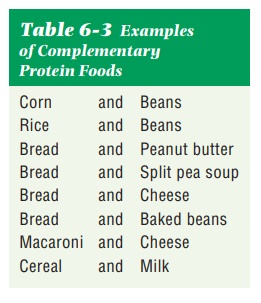Chapter: Nutrition and Diet Therapy: Proteins
Classification of Proteins
CLASSIFICATION
The classification and
quality of a protein depends on the number and types of amino acids it
contains. There are 20 amino acids, but only 10 are considered essential to
humans (Table 6-2). Two additional amino acids are sometimes incorporated into
proteins during translation: selenocyteine and pyrrolysine. Essential amino
acids are necessary for normal growth and development and must be provided in
the diet. Proteins containing all the essential amino acids are of high
biologic value; these proteins are called complete
proteins and are extremely bioavailable. The nonessential amino
acids can be produced in the body from the essential amino acids, vitamins, and
minerals.

Incomplete proteins are those that lack
one or more of the essentialamino acids. Consequently, incomplete proteins
cannot build tissue without the help of other proteins. The value of each is
increased when it is eaten in combination with another incomplete protein, not
necessarily at the same meal but during the same day. In this way, one
incomplete protein food can provide the essential amino acids the other lacks.
The combination may thereby pro-vide all the essential amino acids (Figure
6-1). When this occurs, the proteins are called complementary
proteins (Table 6-3). Gelatin is the only protein from an animal source
that is an incomplete protein.


Related Topics